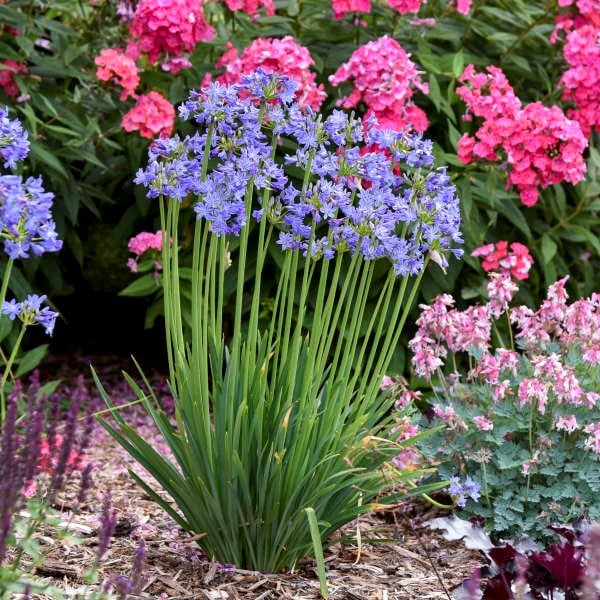Agapanthus Treatment Tips for Lush and Vibrant Flowers
Agapanthus Treatment Tips for Lush and Vibrant Flowers
Blog Article
Unleashing the Secret to Successful Agapanthus Farming: Idea for a Flourishing Garden
In the world of gardening, growing agapanthus efficiently calls for a tactical strategy that includes various facets of plant treatment. With cautious focus to detail, one can unlock the keys to nurturing these sensational blooms, bring about a yard that flourishes with appeal and vibrancy. By understanding the subtleties of agapanthus farming, one can develop an environment where these plants prosper and bloom perfectly. In the adhering to conversation, we will discover essential suggestions and techniques that will direct you towards a growing agapanthus yard, using understandings right into finest practices, dirt problems, watering techniques, and a lot more.
Growing Agapanthus: Best Practices
When planting Agapanthus, proper dirt preparation is necessary for making certain effective growth and development of these attractive blossoms. Agapanthus, generally referred to as Lily of the Nile or African lily, thrives in well-draining dirt with a slightly acidic to neutral pH level - Agapanthus. Before growing, it is crucial to amend hefty clay soils with organic issue such as garden compost or peat moss to enhance drainage and supply essential nutrients for the plants
To plant Agapanthus, pick an area that gets complete sunshine to partial shade, as this will promote healthy and balanced development and abundant blooming. Dig an opening two times the size of the plant's origin sphere and put the Agapanthus at the exact same depth it was previously expanding. Gently backfill the hole with soil, weighing down strongly to eliminate any air pockets around the roots.
Water the recently planted Agapanthus completely and remain to keep the dirt equally moist, specifically throughout the plant's energetic growing period. Agapanthus. Using a balanced fertilizer once a month can additionally support the plant's growth and blooming. By following these best techniques for growing Agapanthus, you can produce a sensational display of these exciting flowers in your yard
Ideal Dirt Issues for Agapanthus
For ideal growth and blooming success of Agapanthus plants, guaranteeing the soil problems are perfect is important. Agapanthus favors soil that is rich in nutrients, so including a well balanced plant food throughout the growing period can promote healthy growth and vibrant flowers.

Watering and Fertilizing Tips
To ensure healthy growth and vivid blooms, correct watering and fertilizing strategies are crucial for successful Agapanthus cultivation. Agapanthus plants gain from regular watering, specifically throughout the growing season. It is advised to water deeply as soon as a week, guaranteeing the soil is damp however not soaked. Throughout warm weather or in pots, more frequent watering may be needed to stop the soil from drying out completely.
When it comes to feeding Agapanthus, a well balanced fertilizer with equal parts nitrogen, phosphorus, and potassium can be used in the springtime to advertise healthy growth and flowering. Slow-release plant foods are excellent for supplying nutrients gradually over an extensive duration. Avoid over-fertilizing, as this can cause excessive vegetation growth at the expense of flowers.
Furthermore, integrating raw material like compost right into the soil can boost nutrient levels and enhance dirt framework, helping in the total wellness of the Agapanthus plants. By complying with these watering and fertilizing suggestions, gardeners can guarantee their Agapanthus plants flourish and produce stunning displays of blossoms.
Trimming and Deadheading Strategies
Appropriate trimming and deadheading methods play a critical role in keeping the wellness and aesthetics of Agapanthus plants, complementing the vital methods of watering and feeding for effective farming. Pruning Agapanthus involves removing spent blossom heads, yellowing or dead leaves, check this and total shaping of the plant to advertise much better growth. Deadheading, the procedure of eliminating faded flowers, not only improves the plant's appearance however likewise encourages additional growing.
When deadheading Agapanthus, it is a good idea to trim off the flower stem at the base making use of sharp, clean shears. This process reroutes the plant's power from seed manufacturing back right into root and vegetation development, advertising a much healthier and more robust plant. Regular deadheading can extend the flowering period of Agapanthus and avoid self-seeding, which can lead to congestion.
In terms of pruning, Agapanthus generally gain from a light trim after flowering to clean up the plant and urge fresh growth. Cutting down the invested blossom stems and removing any broken or dead vegetation helps preserve the plant's vigor and general look. Nonetheless, it is necessary to stay clear of cutting into the crown of the more info here plant, as this can weaken its health and wellness.

Protecting Agapanthus From Pests and Diseases
Executing reliable parasite and illness management strategies is critical to securing the wellness and vitality of Agapanthus plants in cultivation. One common parasite that affects Agapanthus is the Agapanthus borer, a caterpillar that tunnels into the plant, causing damages to the leaves and flowers.
In addition to pests, Agapanthus are vulnerable to diseases such as root rot and fungal fallen leave places. By remaining alert and addressing insect and condition problems quickly, garden enthusiasts can aid their Agapanthus grow and thrive.

Final Thought
In final thought, effective cultivation of agapanthus requires correct planting techniques, ideal soil problems, appropriate watering and fertilizing, regular trimming and deadheading, and defense from insects and diseases. By following these pointers and methods, gardeners can guarantee a prospering yard loaded with lovely agapanthus blooms. Agapanthus. Bear in mind to keep consistent care and interest to detail to promote the wellness and longevity of these stunning plants
When growing Agapanthus, proper soil preparation is essential for making certain effective growth and development of these lovely flowers.Water the freshly grown you could try here Agapanthus thoroughly and proceed to keep the dirt evenly damp, specifically during the plant's active expanding period.For optimum growth and flowering success of Agapanthus plants, making certain the soil problems are suitable is essential. When hair transplanting or planting Agapanthus, ensure the soil is well-prepared to supply the necessary foundation for the plants to establish themselves efficiently. One typical insect that affects Agapanthus is the Agapanthus borer, a caterpillar that tunnels into the plant, causing damage to the fallen leaves and blossoms.
Report this page